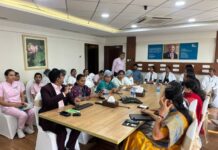Addresses the 20th Anniversary Celebrations of CanSupport
Delhi, November 14, 2016: The Vice President of India, Shri M. Hamid Ansari has said that neglect of healthcare will have a negative impact on India’s economy combined with rising population. He was addressing on the occasion of 20th Anniversary Celebrations of CanSupport, an NGO providing palliative care for cancer patients, here today.
The Vice President said that with more than 1,300 persons succumbing to cancer every day, it has become one of the major causes of deaths in our country. The distressing aspect is that these cancers can be prevented, screened for and/or detected early and treated at an early stage to significantly reduce the death rate, he added.
The Vice President said that despite improvements in access to health care, inequalities related to socioeconomic status, geography, and gender continue to remain, and are being compounded by high out-of-pocket expenditures, with more than three-quarters of the increasing financial burden of health care being met by households. The total allocation on Health remains inadequate and much below the amount required to address the yawning gaps, he added.
The Vice President said that the lack of sufficient public allocations has resulted in huge demand-supply gaps in cancer detection, treatment and care requirements. He further said that responding to palliative care needs of cancer patients requires not only the medical and nursing needs of the person affected but also the patient’s emotional and spiritual distress and support for the caregivers. Provision of palliative care services therefore assumes an important dimension of overall cancer care in our country and CanSupport has been a trailblazer in this field, he added.
Following is the text of Vice President’s address:
“It is a pleasure to be here to mark the 20th anniversary of CanSupport’s continuing work to bring care and respite to cancer patients in Delhi.
With more than 1,300 persons succumbing to it every day, cancer has become one of the major causes of deaths in our country. According to the National Cancer Registry Programme of the India Council of Medical Research (ICMR), the estimated mortality rate due to cancer saw an increase of about 6% between 2012 and 2014. It has been estimated that;
· Around 2.5 million people are living with cancer in India
· Over 7 lakh new cases are registered every year
· One woman dies of cervical cancer every 8 minutes
· For every 2 women newly diagnosed with breast cancer, one woman dies of it in India
· As many as 2,500 persons die every day due to tobacco-related diseases in India.
The distressing aspect is that these cancers can be prevented, screened for and/or detected early and treated at an early stage to significantly reduce the death rate.
Despite improvements in access to health care, inequalities related to socioeconomic status, geography, and gender continue to remain, and are being compounded by high out-of-pocket expenditures, with more than three-quarters of the increasing financial burden of health care being met by households.
Increased health-care expenditures exacerbate poverty. An article in the venerable medical journal, The Lancet, recently estimated that about 39 million additional people in our country fall into poverty every year as a result of medical expenditures.
Some of the indicators about the overall healthcare situation in India are of concern;
· Notable gap exists between the demand for healthcare workforce and the actual supply ― India has only 0.7 doctors per 1,000 patients in comparison to WHO stipulated minimum doctor-to-patient ratio of 1:1,000;
· About 15,000 doctor positions at primary health centres are lying vacant;
· Hospital bed density in India is 0.9 per 1,000 persons, which is significantly short of World Health Organisation (WHO) – guidelines of 3.5 per 1,000;
· 682 out of every 100,000 people die from non-communicable diseases, as against the global figure of 539;
· According to the WHO, India still accounts for the highest maternal deaths and still births in the world;
· 4,000 out of 5,000 community health centres do not have even a single obstetrician;
· India’s per capita spending on healthcare is the lowest among BRICS countries;
· Low spend on healthcare as a percentage of GDP is insufficient to meet the demands of a growing population and disease burden. Moreover, there is a significant need to implement a robust plan for effective utilisation of existing budgets so that public expenditure is fully utilised;
· Absence of universal health coverage and limited social health coverage has led to a high burden of Out- Of-Pocket expenditure (OOP) in India. OOP contributes approximately 86% of private expenditure and 60% of overall healthcare expenditure in our country;
Based on recommendations of the National Health Policy (2002), budget allocations to the health sector progressively increased every year from 2005. By 2010, budgetary allocations had increased from Rs 10,000 crores to Rs 30,000 crores- from 0.9% of total GDP to about 1.3%. Most of these increased allocations went to the National Rural Health Mission aimed at systemic corrections in India’s public health system, and to support healthcare in the lesser developed states.
The draft Twelfth Five Year Plan and draft health policy 2015 had committed the country to increase public expenditure on health to 2.5% of GDP. This would have required an increase of 30-40% in the Union health budget every year, matched with increased allocations in the state budgets. Knowing that the fiscal space in some of the states with the poorest health status is likely to be the smallest, Union budget needed to provide a larger share.
The total allocation on Health in the latest budget was Rs 33,000 crores – reflecting an increase of 13% over last year’s allocation, which had earlier seen a reduction in allocation. This allocation remains inadequate and much below the amount required to address the yawning gaps.
Neglect of healthcare will have a negative impact on India’s economy combined with rising population. For us, health is an issue of national security. We cannot protect the sovereignty of the nation, or ensure sustainable development unless we have a healthy population. We cannot aspire to be a world power when millions do not have access to affordable health care.
India is the one of the few developing countries that has formulated a National Cancer Control Programme. The programme envisages control of tobacco related cancers; early diagnosis and treatment of uterine cervical cancer; and distribution of therapy services, pain relief and palliative care through augmentation of health infrastructure. Suggested surrogate outcome measures include change in tobacco use, ‘Knowledge, Attitude, Practice’ (KAP) pattern, compliance to screening programmes, changes in referral practices and shift in stage distribution.
Yet, the lack of sufficient public allocations has resulted in huge demand-supply gaps in cancer detection, treatment and care requirements. A majority of cancer related death in India are because of late detection of the disease due to the lack of diagnostic facilities at the peripheral levels. It is estimated that more than 75% of cancers in India are present in advanced stages and palliative care and pain relief are essential to provide good quality life for these patients.
Provision of palliative care services therefore assumes an important dimension of overall cancer care in our country. The large gap between the public provisions and the actual requirement in this regard is being met to a degree by NGOs and civil society initiatives. Half way homes and Hospices run by Non Governmental Agencies have been doing yeoman service, especially when they are attached to a major cancer treatment centres.
CanSupport has been a trailblazer in this field. The film that we just saw gave us a glimpse of what it does, how it does it, and what comfort and solace it brings by caring for people in their own homes at a difficult time in their lives.
Responding to palliative care needs of cancer patients requires not only the medical and nursing needs of the person affected but also the patient’s emotional and spiritual distress and support for the caregivers.
CanSupport’s home based services bring this care to the doorstep of those too sick to travel. It is cost effective, as it cuts down on repeated, and usually unnecessary, visits to the hospital for investigations and treatments. It is also well suited to Indian conditions where a family member is available and willing to nurse the sick person. I commend CanSupport for choosing and developing this model of care.
Beginning with one team and 6 patients, CanSupport today supports almost 2000 cancer patients, most of them poor, being cared for in their homes, free of charge. This is no small feat. It shows the dedication and determination of the team at CanSupport.
I congratulate the CanSupport team and their supporters for all they have accomplished and wish them the very best for the future.






















